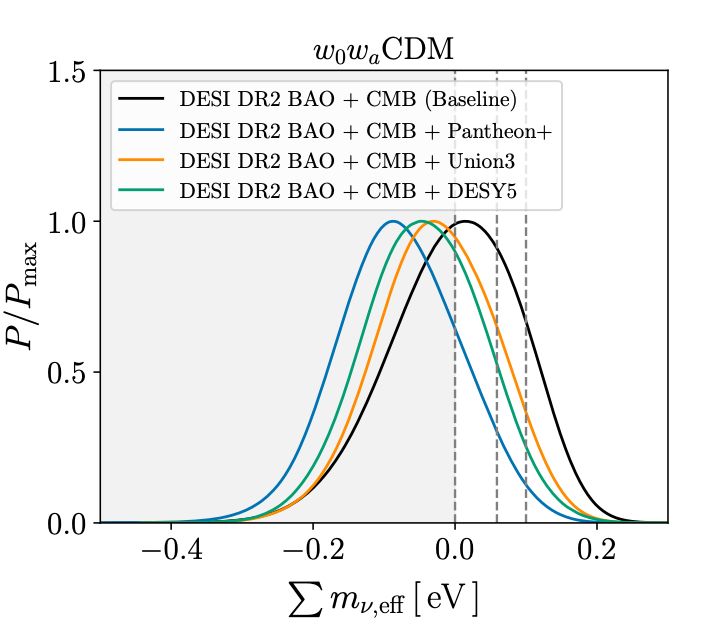
Congrats to @jfdonoghue.bsky.social !

Congrats to @jfdonoghue.bsky.social !
arxiv.org/abs/2508.20999

arxiv.org/abs/2508.20999
Fact check: astrophysics provides a constraint that is 20 orders of magnitude stronger than this new result.



Fact check: astrophysics provides a constraint that is 20 orders of magnitude stronger than this new result.



DESI does not show that w0wa explains there data. Eg neutrino mass remains negative even with w0wa

DESI does not show that w0wa explains there data. Eg neutrino mass remains negative even with w0wa
arxiv.org/abs/1612.00033
Cabass et al. show that inflation predicts a lower bound of equilateral NG of 0.1 x (n_s-1), 3-4 orders of magnitude below the current limits, due to gravity. The search for NG has a set range and target

arxiv.org/abs/1612.00033
Cabass et al. show that inflation predicts a lower bound of equilateral NG of 0.1 x (n_s-1), 3-4 orders of magnitude below the current limits, due to gravity. The search for NG has a set range and target

arxiv.org/abs/0912.5516
Fergusson et al. define a basis of orthogonal polynomials on the space of CMB 3pt functions, vastly reducing the need to find models on which to build non-Gaussian templates. Planck bounds the first 2000 terms.

arxiv.org/abs/0912.5516
Fergusson et al. define a basis of orthogonal polynomials on the space of CMB 3pt functions, vastly reducing the need to find models on which to build non-Gaussian templates. Planck bounds the first 2000 terms.
arxiv.org/abs/hep-ph/9...
Donoghue shows how to use subtracted dispersion relations to expose the structure of EFT. Specifically, this technique precisely illustrates UV information can be traded to local contact interactions.

arxiv.org/abs/hep-ph/9...
Donoghue shows how to use subtracted dispersion relations to expose the structure of EFT. Specifically, this technique precisely illustrates UV information can be traded to local contact interactions.
arxiv.org/abs/0803.1467
arxiv.org/abs/1212.4103
This paper gives a very clear (first) demonstration of this strategy

arxiv.org/abs/0803.1467
arxiv.org/abs/1212.4103
This paper gives a very clear (first) demonstration of this strategy
arxiv.org/abs/0801.1140
While officially addressing the topic of "unparticles", Grinstein et al. rederive bounds on the dimensions of operators from the unitarity of scattering a weakly coupled spectator off a strongly coupled CFT

arxiv.org/abs/0801.1140
While officially addressing the topic of "unparticles", Grinstein et al. rederive bounds on the dimensions of operators from the unitarity of scattering a weakly coupled spectator off a strongly coupled CFT
arxiv.org/abs/1602.05196
Mirbabayi & Simonovic show that the photon and graviton soft theorems for scattering in flat space are a consequence of physical long wavelength configurations tied to large diffs (BSM)

arxiv.org/abs/1602.05196
Mirbabayi & Simonovic show that the photon and graviton soft theorems for scattering in flat space are a consequence of physical long wavelength configurations tied to large diffs (BSM)
arxiv.org/abs/1108.0874
Creminelli shows that the structure of cosmic observables follows from conformal Ward identities. He gives simple examples at 3- and 4-points that are a starting point for more complex problems

arxiv.org/abs/1108.0874
Creminelli shows that the structure of cosmic observables follows from conformal Ward identities. He gives simple examples at 3- and 4-points that are a starting point for more complex problems

arxiv.org/abs/1603.03091
Pan et al. use (semi-)analytic methods to model the location of all the CMB peaks at the level of the Planck peak measurements in TTTEEE (<1%). Many corrections are 1-10% and thus are essential for consistency with data.

arxiv.org/abs/1603.03091
Pan et al. use (semi-)analytic methods to model the location of all the CMB peaks at the level of the Planck peak measurements in TTTEEE (<1%). Many corrections are 1-10% and thus are essential for consistency with data.
arxiv.org/abs/1508.01082
Maldacena writes down a model of inflation where the statistics of certain hot and cold spots encode the outcome of a Bell-measurement. This shows that the quantum nature of inflation can survive in conventional classical observables

arxiv.org/abs/1508.01082
Maldacena writes down a model of inflation where the statistics of certain hot and cold spots encode the outcome of a Bell-measurement. This shows that the quantum nature of inflation can survive in conventional classical observables

arxiv.org/abs/astro-ph...
Zaldarriaga & Harari give a thorough analytic treatment of how polarized scattering affects the evolution of the photon distribution function and the appearance of temperature and polarized CMB anisotropies

arxiv.org/abs/astro-ph...
Zaldarriaga & Harari give a thorough analytic treatment of how polarized scattering affects the evolution of the photon distribution function and the appearance of temperature and polarized CMB anisotropies
arxiv.org/abs/hep-th/0...
He nicely explains why this type of solution usually doesn't work: vacuum loops contribute to the mass/energy of many states and must couple to gravity universally.

arxiv.org/abs/hep-th/0...
He nicely explains why this type of solution usually doesn't work: vacuum loops contribute to the mass/energy of many states and must couple to gravity universally.
arxiv.org/abs/hep-th/0...
arxiv.org/abs/hep-th/0...
Sundrum tries to construct a theory of gravity where vacuum loops don't gravitate. This theory is non-local in a non-trivial way in order to avoid the very strong equivalence principle constraints in this idea.

arxiv.org/abs/hep-th/0...
arxiv.org/abs/hep-th/0...
Sundrum tries to construct a theory of gravity where vacuum loops don't gravitate. This theory is non-local in a non-trivial way in order to avoid the very strong equivalence principle constraints in this idea.
arxiv.org/abs/0807.0004
This program has had much broader applications in understanding CFTs. However, the original idea is still interesting, particularly for models with weakly broken conformal invariance.

arxiv.org/abs/0807.0004
This program has had much broader applications in understanding CFTs. However, the original idea is still interesting, particularly for models with weakly broken conformal invariance.
arxiv.org/abs/hep-ph/0...
Luty & Okui rephrase the hierarchy problem as a statement about the relationship between the dimensions of operators. The idea is that the Higgs has a dimension near 1 but all the operators in its OPE have dimensions > 4.

arxiv.org/abs/hep-ph/0...
Luty & Okui rephrase the hierarchy problem as a statement about the relationship between the dimensions of operators. The idea is that the Higgs has a dimension near 1 but all the operators in its OPE have dimensions > 4.
arxiv.org/abs/hep-th/0...
Low & Manohar explain why there are often fewer Goldstone modes than broken generators for spacetime symmetries. A goldstone acts like a local symmetry, which is not unique to a single global generator.

arxiv.org/abs/hep-th/0...
Low & Manohar explain why there are often fewer Goldstone modes than broken generators for spacetime symmetries. A goldstone acts like a local symmetry, which is not unique to a single global generator.

